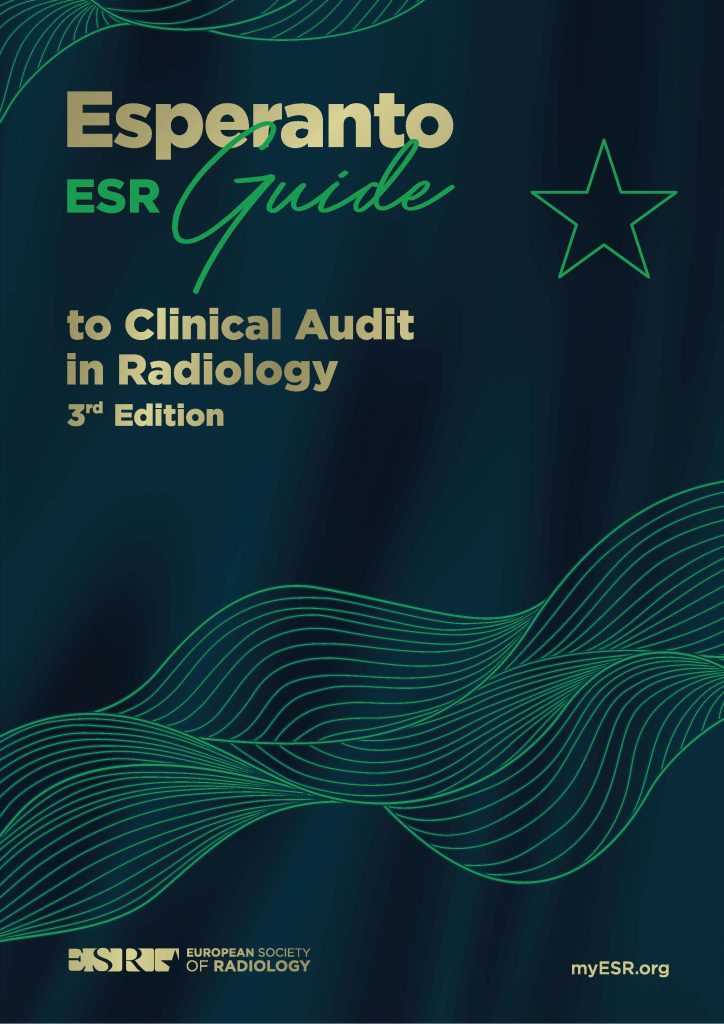Clinical Audit
Improving the quality of patient care through systematic review against defined standards
The ESR perspective on clinical audit
The ESR cooperates with institutions including the European Commission and the Heads of the European Radiation Protection Competent Authorities (HERCA) to ensure that clinical audit is applied properly to improve quality of patient care in Europe, but also to understand the regulators’ perspective for its efforts regarding audit.
In the context of the implementation of the Basic Safety Standards Directive, the ESR works with stakeholders to increase awareness of clinical audit among radiologists and to provide radiology departments with a toolkit to perform audits effectively.
The ESR Clinical Audit booklet - Esperanto 2022

The ESR Audit and Standards Subcommittee, under the guidance of David Howlett, Chair of the ESR Audit and Standards Subcommittee, and Núria Bargalló, Chair of the ESR Quality, Safety and Standards Committee, has developed the updated 3rd Edition of Esperanto, ESR Guide to Clinical Audit in Radiology.
This third iteration of Esperanto offers an enhanced clinical audit guide and an expanded section of audit templates. The purpose of this document is to further increase awareness and understanding of clinical audit within radiology departments across Europe and to support departments in developing effective clinical audit practice and processes.
The Esperanto booklet was named after the most successful constructed language in the world, Esperanto, created by the Polish ophthalmologist Ludwik L. Zamenhof, and offers an overview of the ESR Clinical Audit initiative.
Have you used the ESR’s template in your department? We’d be happy to hear about your experience!
Esperanto is available in the following languages: English and Hungarian.
Audit Templates
Download our audit templates here:
List of audit templates:
- Complication rates and diagnostic adequacy rates for percutaneous CT guided lung biopsy
- Record of safety checklist and patient consent prior to interventional procedures
- Adequate discussion of treatment proposals of oncological patients in a multi-disciplinary meeting (MDM)/tumour board
- Improving referral process and guidelines – specific target: implementation of referral guidelines through iGuide – integrated directly into hospital ordering systems
- Protocols around radiological procedures, information in reports
- The practice of ‘routine’ preoperative chest X-rays
- Audit appropriateness of inpatient chest X-rays or abdominal X-rays
- What percentage of non-ionising imaging studies (MR/ultrasound) are consistent with referral guidelines
- Pain sensation during image-guided interventions
- Image quality in radiography
- Image quality in CT
- Justification of head CT
- Incidence of contrast extravasation during CT injection and impact on patients
- Impact of patient misidentification errors and subsequent error rates of this type
- Reject analysis of radiological images
- Impact of a local training programme on first line reporting accuracy by junior doctors
- Auditing the Appropriateness of CT referrals
- Adequate completion of radiology request forms for X-ray and CT
- Impact of departmental CT dose reducing protocol on image quality and diagnostic confidence
- Impact of variation in volume of injected contrast in CT on image quality, diagnostic confidence and dose
- Impact of adjusting frame/pulse rate in fluoroscopy on image quality, diagnostic confidence and dose
- Adequacy of CT colonography (insufflation/bowel preparation)
- Adequacy of irradiation beam size (collimation) in projection radiography
- Radiographic image labelling – use of anatomical side markers for projection radiography
- Reject rate for projection radiographs
- Existence of predetermined CT technical protocols for each specific indication
- How dose information should be transmitted to the patient
- Follow-up of patient with high skin dose as a result of an interventional procedure
- Key points on how to manage patient radiation protection
- Waiting time for outpatient ultrasound appointments
- Does the radiology department record statistics about patient satisfaction?
List of audit templates:
- Is there a departmental mechanism for providing patients (or their representative) with information relating to the risk/benefits associated with radiation dose from the medical exposure?
- Is there an established mechanism within the department to register and analyse accidental /unintended exposure?
- Is there a departmental policy for informing patients, or their representative, that they have undergone and accidental exposure?
- Is there a mechanism for record keeping and retrospective analysis of accidental or unintended medical exposures?
- Is there a mechanism for referring accidental exposure events to the medical physics expert (MPE) and informing the competent authority of significant events?
- Does the department utilise criteria, provided by the relevant radiation protection competent authority, for what constitutes an accidental or unintended significant exposure?
- Is there evidence of appropriate training for individuals (particularly non-radiologists) with responsibility for justification?
- Is there a departmental mechanism to confirm as necessary with the patient or patient representative and document the non-pregnancy status of individuals undergoing medical exposures?
- Is there a written protocol for the identification of who is responsible for the justification process?
- For radiation exposure related to health screening by invitation on asymptomatic individuals, is there a local policy affirming justification by a competent authority?
- What percentage of examinations involving ionising radiation are justified in advance of being performed?
- What mechanism exists on the request form for contacting referrers to permit pre-exposure justification discussions to occur if necessary?
- Is there a written protocol for who may be responsible for justification of X-ray / fluoroscopic / interventional ionising radiological procedures?
- Is there a written protocol for who may be responsible for justification of CT examinations?
- What mechanism is used to evaluate patient dose in high-dose procedures?
- What percentage of radiodiagnostic procedures have established diagnostic reference levels (DRL)?
- Specific technical requirements for equipment in use for medical exposures.
- Eye lens dose limits for occupational exposure.
- Initial education and training in radiation protection.
- Audit of education plus training in radiation protection, doses and side effects.
- Provision of clinical information to support justification.
- Staff dosimetry audit – this includes a draft adapted questionnaire.
- Evaluation of the role and responsibilities of the medical physics expert.









